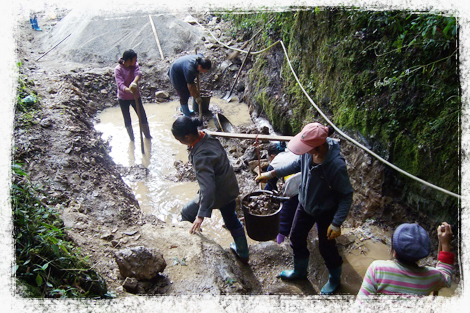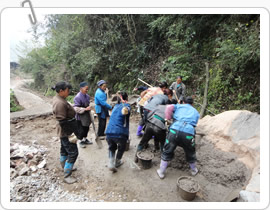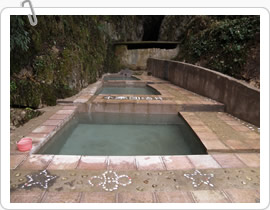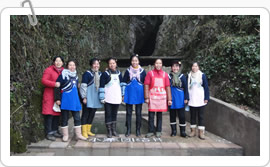 |
| Villagers restore the well in self-help mode, through their own efforts. |
 |
| Villagers are enthusiastic about restoring the well. |
 |
| The “United Well” has finally been restored. |
 |
| Villagers feel happy about the successful restoration of the well, and the result in enhanced unity among residents. |
People in a small village in Guizhou have restored a deserted well through their own efforts, under a collaboration with Partnerships for Community Development (PCD) and the Guizhou Institute of Biotechnology. The move has not only made a water supply possible and addressed the drought problem but also unexpectedly resulted in enhancing the unity of the villagers. Moreover, since the restoration of the well, the villagers have also resumed some of their traditional practices and customs.
Wa Yao Village, a mountainous village inhabited by the Boyi race, is in Niu Chang Township of Guiyang City, Guizhou Province. The place experienced drought for months in 2011. There is a place called Xiao Zhai in Wa Yao Village where there is a well. But the well was blocked several years ago, following the opening-up of mountains nearby with the use of explosives. Later the well dried up. As the villagers enjoyed running mains water they had gradually forgotten the well, which was later totally abandoned.
When the drought problem emerged, the running water could only be supplied intermittently. Thus the villagers had to go somewhere else to fetch water. They strongly wanted to restore the old well. After numerous meetings between the villagers and the Guizhou Institute of Biotechnology, both parties agreed to repair and restore the well. The collaboration took place as PCD provided financial resources to buy building materials, while the labour was supplied by all villagers as volunteers. The villagers also agreed that local rock materials, local skilled labour and local wisdom from Wa Yao Village should be adopted; the purchase of raw materials, the accounts and financial records should be transparent and open to the villagers; and all Xiao Zhai villagers would be involved in the construction process which would be organised and implemented by “the Go-Between Communicators”*.
At the beginning of the work process, the Go-Between Communicators and several villagers entered the well several times for investigations, making sure there would be a water supply before any restoration was launched.
During the restoration process, the Go-Between Communicators were to implement the division of labour. They decided how many villagers would take part in the construction work each day according to workload. Villagers were enthusiastic and actively took part in the work. They also tried to lower the cost, as far as possible, under the principle of guaranteeing work quality. For example, the Go-Between Communicators Luo Xiuqiong and Ban Xiaofen made use of their work experience gained in rock mines, preferring to buy raw rocks and polish them with their own skills. This saved some expense. Another villager, Liu Jizhen, had her own rock mine, which provided rocks to villagers at reduced prices.
All types of villagers were involved in the work process, be they male or female, young or elderly. The oldest was over 80 while the youngest was 18. Eighty-year-old Tang Xiuzhen said, “I am old and can’t help much with laborious work, but it’s not a bad idea to come here to keep up morale.” Men took up technical and laborious works while women engaged in less arduous tasks such as fetching sand, preparing mortar and placing rocks in suitable places. A villager with a crippled hand helped fetch sand, liaise for receiving raw materials and issuing receipts. He said, “I can’t take up arduous tasks but can still do something by running here and there.”
By the last phase of the work process, all 33 households of the Village had participated in the work in one way or another.
All four of the Go-Between Communicators committed a great deal of energy and time to organising villagers, buying and transporting materials and even spending their evenings checking financial accounts and holding meetings. They also established an internal system for financial management. The import and management of materials, the accounts and cash management were all well taken care of, and all the information about such work was always ready to go public.
The repair and restoration of this “United Well” took two months, and the well was finally able to supply water. The water comes from a pipe placed 300 metres inside the hole and there are three mouths for the well, supplying water for washing clothes and vegetables. To beautify the environment surrounding the well, villagers took the initiative to fetch flowers from nearby mountains and plant them around it. People are concerned very much for the hygiene of the area surrounding the well, and so they take turns to clean the area.
The repair and restoration of the well has not only solved the problem of the water supply but has unexpectedly boosted the unity among the villagers. As the villagers made a concerted effort, in self-help mode, to happily restore the well, they named it the “United Well”.
After successfully restoring the well, villagers discussed among themselves and vowed to protect the environment, respect nature, and comply with laws and rules so as to prevent the well water and environment around Xiao Zhai from being contaminated and enable it to stay clean and beautiful. Villagers will discuss the penalties if anyone infringes the rules.
The united spirit among villagers nurtured during the process of restoring the well has also led the villagers to resume one of their traditional customs – the “Flames Session”. The session is to be hosted annually by four households. During the session, the villagers gather by the well for meal and at the same time discuss community affairs. Priests invite each household to clean and pray for blessings for villagers.
* The Go-Between Communicators are the core members of the Village participating in PCD’s projects. They are responsible for reporting the work progress of the projects to the rest of the villagers, hence the nickname.
Note: The original text was provided by Ding Ying, a researcher from the Guizhou Institute of Biotechnology.

